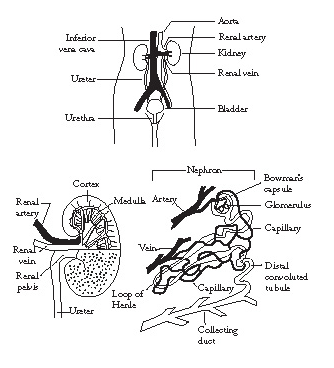Human Excretory System
The human excretory system functions to remove waste from the human body.
It involves the processing and removal of undigested food. This system consists of specialized structures and capillary networks that assist in the excretory process.
The human excretory system includes the kidneys and their functional unit, the nephron.
The excretory activity of the kidneys is modulated by specialized hormones that regulate the amount of absorption within the nephron.
Kidneys
The human kidneys are the major organs of bodily excretion.
They are bean-shaped organs located on either side of the backbone at about the level of the stomach and liver.
Blood enters the kidneys through renal arteries and leaves through renal veins.
Tubes called ureters carry waste products from the kidneys to the urinary bladder for storage or for release.
The product of the kidneys is urine, a watery solution of waste products, salts, organic compounds, and two important nitrogen compounds: uric acid and urea.
Uric acid results from nucleic acid decomposition, and urea results from amino acid breakdown in the liver.
Both of these nitrogen products can be poisonous to the body and must be removed in the urine.

Figure Above shows the Details of the human excretory system.
Position and allied structures of the kidneys (top).
A cross section of the kidney showing the two major portions (left).
Details of the nephron, the functional unit of the kidney (right).
Nephron
The functional and structural unit of the kidney is the nephron.
The nephron produces urine and is the primary unit of homeostasis in the body.
It is essentially a long tubule with a series of associated blood vessels.
The upper end of the tubule is an enlarged cuplike structure called the Bowman’s capsule.
Below the Bowman’s capsule, the tubule coils to form the proximal tubule, and then it follows a hairpin turn called the loop of Henle.
After the loop of Henle, the tubule coils once more as the distal tubule.
It then enters a collecting duct, which also receives urine from other distal tubules.
Within the Bowman’s capsule is a coiled ball of capillaries known as a glomerulus.
Blood from the renal artery enters the glomerulus.
The force of the blood pressure induces plasma to pass through the walls of the glomerulus, pass through the walls of the Bowman’s capsule, and flow into the proximal tubule.
Red blood
After plasma enters the proximal tubule, it passes through the coils, where usable materials and water are reclaimed.
Salts, glucose, amino acids, and other useful compounds flow back through tubular cells into the blood by active transport.
Osmosis and the activity of hormones assist the movement.
The blood fluid then flows through the loop of Henle into the distal tubule.
Once more, salts, water, and other useful materials flow back into the bloodstream.
Homeostasis is achieved by this process: A selected amount of hydrogen, ammonium, sodium, chloride, and other ions maintain the delicate salt balance in the body.
The fluid moving from the distal tubules into the collecting duct contains urine.
The urine flows through the ureters toward the urinary bladder.
When the bladder is full, the urine flows through the urethra to the exterior.
Control of kidney function
The activity of the nephron in the kidney is controlled by a person’s choices and environment as well as hormones.
For example, if a person consumes large amounts of protein, much urea will be in the blood from the digestion of the protein.
Also, on a hot day, a body will retain water for sweating and cooling, so the amount of urine is reduced.
Humans produce a hormone called antidiuretic hormone (ADH), also known as vasopressin, which is secreted by the posterior lobe of the pituitary gland.
It regulates the amount of urine by controlling the rate of water absorption in the nephron tubules.
Some individuals suffer from a condition in which they secrete very low levels of ADH.
The result is excessive urination and a disease called diabetes insipidus.
Another unrelated form of diabetes, diabetes mellitus, is more widespread.
People with this disease produce insufficient levels of insulin.
Insulin normally transports glucose molecules into the cells.
But when insulin is not available, the glucose remains in the bloodstream.
The glucose is removed from the bloodstream in the nephron; to dilute the glucose, the nephron removes large amounts of water from the blood.
Thus, the urine tends to be plentiful.
Hormones from the cortex of the adrenal glands also control the content of urine.
These hormones promote reabsorption of sodium and chloride ions in the tubules.
Thus, they affect the water balance in the body because water flows in the direction of high sodium and chloride content.
Scholarship 2025/26
Current Scholarships 2025/2026 - Fully Funded
Full Undergraduate Scholarships 2025 - 2026
Fully Funded Masters Scholarships 2025 - 26
PhD Scholarships for International Students - Fully Funded!
Funding Opportunities for Journalists 2025/2026
Funding for Entrepreneurs 2025/2026
***
